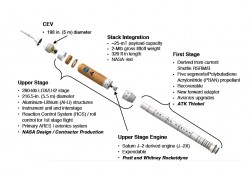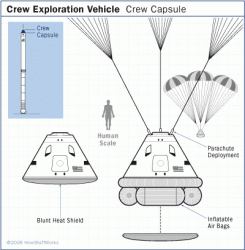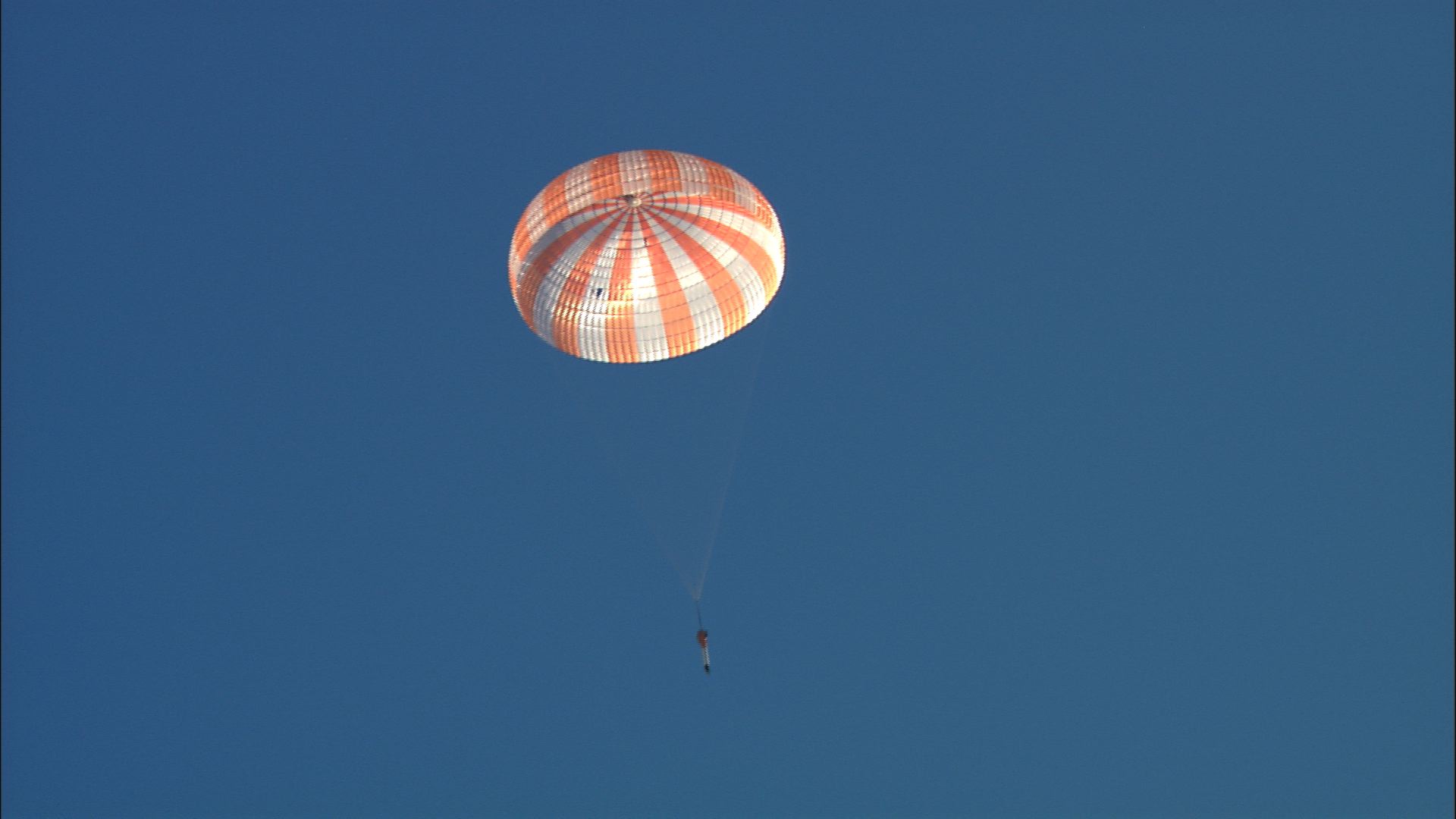[/caption]
At the end of last month, the Orion crew module and the Ares I rocket parachute systems underwent a series of drop tests. The “drogue parachute” that will gently slow the descent of the spent first-stage motor of the Ares vehicle appeared to function as expected over the Arizona skies. However, an Orion test failed, “programmer parachute” failing to correct the orientation of the test crew module, allowing the module to drop through the sky upside-down. The programmer parachute is intended to inflate before the main three parachutes are deployed to bring the re-entering Orion astronauts to land safely. This news has come from an internal memo referring to the Orion test drop back on July 31st; the successful Ares I drogue parachute drop was carried out on July 24th. So what went wrong with the Orion test-drop?
NASA engineers are continuing a series of parachute tests on Orion and Ares. The first parachute system to be employed in any given launch will be the Ares parachute recovery system (assuming the emergency jettison motor isn’t fired before then). At approximately 126 seconds into flight and at an altitude of 189,000 feet (58,000 m), the first Ares I stage will separate, letting the spent booster drop through the atmosphere. To ensure the engine can be re-used by subsequent Constellation launches, the booster’s nose cap will be jettisoned at 15,740 feet (4800 m), releasing a small pilot parachute, dragging a larger drogue parachute out to slow down the rapidly falling first stage.

The drogue is smaller than a conventional parachute and it is intended to slow the booster from 402 mph (647 km/hr) to 210 m/hr (338 km/hr), positioning the cylinder vertically. Only when this slowdown is achieved that the main three cluster of parachutes can be deployed to complete the descent and plunge into the Atlantic Ocean for retrieval.
It would appear that the essential drogue testing of the first stage Ares I booster worked flawlessly when tested by NASA at the U.S. Army’s Yuma Proving Ground near Yuma, Arizona on July 24th. The next drogue test is scheduled for October.
However, during the July 31st Orion parachute test-run, there was a slight technical hitch that gave the Parachute Test Vehicle (PTV) a violent spin and then thud into the ground. The “programmer” parachute is intended to “right” the orientation of the re-entering crew module as it descends, an essential task before the drogue parachutes can be deployed to rapidly slow the module (in a similar way to the Ares I system). Unfortunately, during this PTV test-drop, problems arose very quickly. As soon as the programmer parachute was deployed, it failed to inflate and therefore did not cause any drag. This happened as the programmer parachute was being buffeted by the turbulence in the wake of the PTV and stabilization parachutes. The PTV was therefore allowed to fall ungracefully, upside-down.

Continuing to drop, the programmer and stabilization parachutes were jettisoned (having not done their job very well), and drogue parachutes were deployed. As the PTV was falling out of control, the drogue parachutes were put under immediate strain and wrapped around the PTV, dynamic pressure causing the drogue to be cut away.
Having suffered some major whiplash, the PTV’s main bag retention system was damaged and failed. Continuing to fall, the main parachutes were deployed, two were ripped from the vehicle, forcing the PTV to hit the ground with only one parachute open. There are no details as to what damage was caused by this failed test, but I think we can assume the PTV’s bodywork will be dented (and I wonder if human cadavers were used on this particular drop. If they were, I wouldn’t want to be the first engineer on the scene!).
Although an obvious set-back for the Orion parachute system, the NASA memo highlights that it was a “test technique failure” and not a failure of the technology itself. Regardless, I am sure this issue will be ironed out soon enough as the Constellation Program continues to push ahead with development…
Sources: SpaceRef, Space Travel


“Although an obvious set-back for the Orion parachute system, the NASA memo highlights that it was a ‘test technique failure’ and not a failure of the technology itself.”
In another move by 12 angry scientists, the perchlorate consipracy widens to the Orion system. Sensing an opportunity to launch their case before the world, 12 defensive Mars Phoenix Lander scientists derailed the Orion parachute, citing creative differences with their former Orion cronies. The scientists, wearing cabana shirts and drinking massive amounts of gin, arranged the chute failure. The drunken scientists arrived at a NASA children’s exhibit chanting, “Apollo was a hoax! Long live Phoenix!” Meanwhile, speculation mounted that the 12 Angry Scientists were really working on Project Lucifer. “Project Lucifer is not dead, at least not ’till perchlorate is given its rightful place” one scientist mumbled.
No more coffee for you… 😉
I think the recent events with Russia and its growing squabble in Georgia will soon put Constellation in a new light.
Failures = Bad
Five year gap = Bad
Short of dumping a few hundred billion into the program, is there any way to jump start this thing?
Uh… what is wrong with the parachute technology that we perfected in the 1900s? We do we have to reinvent the wheel on every minute part of this project? That will only make it cost more and take longer to finish.
I follow your blog for quite a long time and must tell you that your posts always prove to be of a high value and quality for readers.